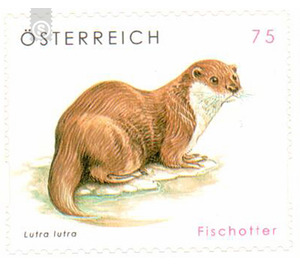animal welfare - Austria / II. Republic of Austria 2010 - 75 Euro Cent
Theme: Animals
| Country | Austria / II. Republic of Austria |
| Issue Date | 2010 |
| Face Value | 75.00 |
| Edition Issued | 500,000 |
| Printing Type | offset |
| Stamp Type | Commemorative |
| Item Type | Stamp |
| Chronological Issue Number | 2184 |
| Chronological Chapter | OOS-OE2 |
| SID | 526086 |
| In 54 Wishlists | |
The brown trout is one of the so-called salmonids predator fish. Their original form was a migratory fish, which, like the salmon, oscillated between fresh and salt water. During the Ice Age, however, the way back into the sea was blocked in many places and so developed several subspecies as well as those of brown trout. This fish, also called river trout, mountain trout or Fario, will, depending on the food supply, 20 to 80 centimeters long. His back is olive-black-brown and silvery blue, he has red spots on the belly side with a bright margin, while the belly itself is white-yellow; his weight is about 2 kg. Hard to believe is the fact that brown trout can reach the age of 18! They populate fast-flowing, oxygen-rich and cool waters with gravel or sand bottom in almost all of Europe. Brown trout are true-to-the-species fish, which leave their place only for reproduction and return even after disturbances to their traditional places. The adult brown trout claims its own territory; During the day it is hidden in the shadow of the sea, with its head against the current. Although the brown trout is considered a fast-swimming hunter, it takes in swamps and streams mostly passing prey (smaller fish, larvae, crustaceans, snails) on. In European waters, there has recently been a strong artificial stocking with the rainbow trout originating from America, which makes less demands on the water quality and is fast growing. For the protection of native fish species, the stocking of alien species has been very limited for some years. The otter - one of the best swimmers among the land predators - belongs to the family of martens. He also occurs in almost all of Europe and is including tail up to 130 inches long. His body is stretched and cylindrical, the legs are short and the head is roundish; on the muzzle are long tactile hairs, which represent an important sense organ in the murky water for him. The toes are connected with webbed skins - and the fish of the otter offers a particularly effective insulation against wet and cold: The hair, similar to a zipper, interlocked by means of microscopically small, interlocking wedges and grooves. It is interesting that there is no uniform way of life of otters. Depending on the environment and individual inclinations, they adapt their way of life in order to survive as well as possible. They are active both at night and on the day - and while they are resting on the shore they move in the water at the time of their activity. The largest enemy of the otter is, as with many animals, man. Habitat destruction and pollution of waters, food shortages, road traffic and fish traps are the main causes why otters rarely reach old age. Today, the species is under protection in most countries. In Austria, the otter is most likely to be found in the Waldviertel and Mühlviertel, some settlements are also found in southern Burgenland and in eastern Styria. However, different protective measures promise success: For about ten years, the stock is gradually increasing again.


